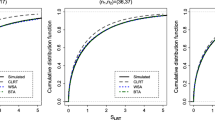Abstract
Consider a one-way layout where random samples of data are available from k populations, where the distributions of the data from each population are considered to be completely unknown. This paper discusses a methodology for investigating whether it can be concluded that the k unknown distributions, or any subsets of these distributions, can be taken to be equal to a common normal distribution, and if so it is shown how to identify these common normal distributions. This is accomplished with an exact specified error rate by constructing confidence sets for the parameters of the common normal distributions using Kolmogorov’s (G. Ist. Ital. Attuari 4:83–91, 1933) procedure. The relationship of this methodology to standard tests of normality and to standard procedures for constructing confidence sets for the parameters of a normal distribution are discussed, together with its relationship to functional data analysis and other standard test procedures for data of this kind. Some examples of the implementation of the methodology are provided.




Similar content being viewed by others
References
Arnold BC, Shavelle RM (1998) Joint confidence sets for the mean and variance of a normal distribution. Am Stat 52:133–140
Delicado P (2007) Functional k-sample problem when data are density functions. Comput Stat 22:391–410
Ferraty F, Vieu P (2006) Nonparametric functional data analysis: theory and practice. Springer, New York
Frey J, Marrero O, Norton D (2009) Minimum-area confidence sets for a normal distribution. J Stat Plan Inference 139:1023–1032
Hayter AJ, Kiatsupaibul S (2013a) Exact inferences for a Weibull model. Qual Eng 25(2):175–180
Hayter AJ, Kiatsupaibul S (2013b) Exact inferences for a Gamma model. Technical Report, University of Denver
Hsu JC (1996) Multiple comparisons—theory and methods. Chapman and Hall, London
Kolmogorov A (1933) Sulla determinazione empirica di una legge di distribuzione. G Ist Ital Attuari 4:83–91
Lehmann EL (1986) Testing statistical hypotheses, 2nd edn. Springer, New York
Lilliefors H (1967) On the Kolmogorov–Smirnov test for normality with mean and variance unknown. J Am Stat Assoc 62:399–402
Mante C, Yao AF, Degiovanni C (2007) Principal component analysis of measures, with special emphasis on grain-size curves. Comput Stat Data Anal 51:4969–4983
Mood AM (1950) Introduction to the theory of statistics. McGraw-Hill, New York
Ramsay J, Silverman BW (2005) Functional data analysis, 2nd edn. Springer, New York
Scott WF, Stewart B (2011) Tables for the Lilliefors and modified Cramer–von Mises tests of normality. Commun Stat, Theory Methods 40(4):726–730
Tamhane AC, Hochberg Y (1987) Multiple comparison procedures. Wiley, New York
Acknowledgements
I would like to sincerely thank each of the reviewers for their helpful and insightful comments and suggestions that have resulted in a much improved version of this manuscript.
Author information
Authors and Affiliations
Corresponding author
Rights and permissions
About this article
Cite this article
Hayter, A. Identifying common normal distributions. TEST 23, 135–152 (2014). https://doi.org/10.1007/s11749-013-0345-3
Received:
Accepted:
Published:
Issue Date:
DOI: https://doi.org/10.1007/s11749-013-0345-3




